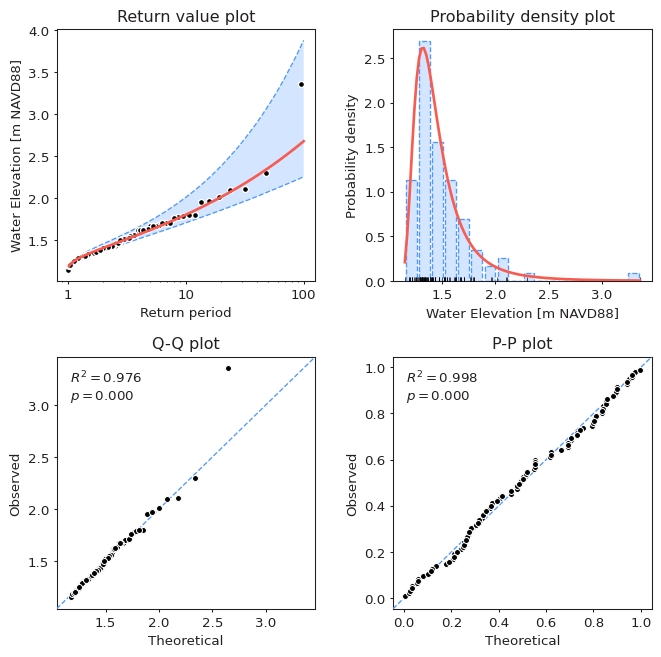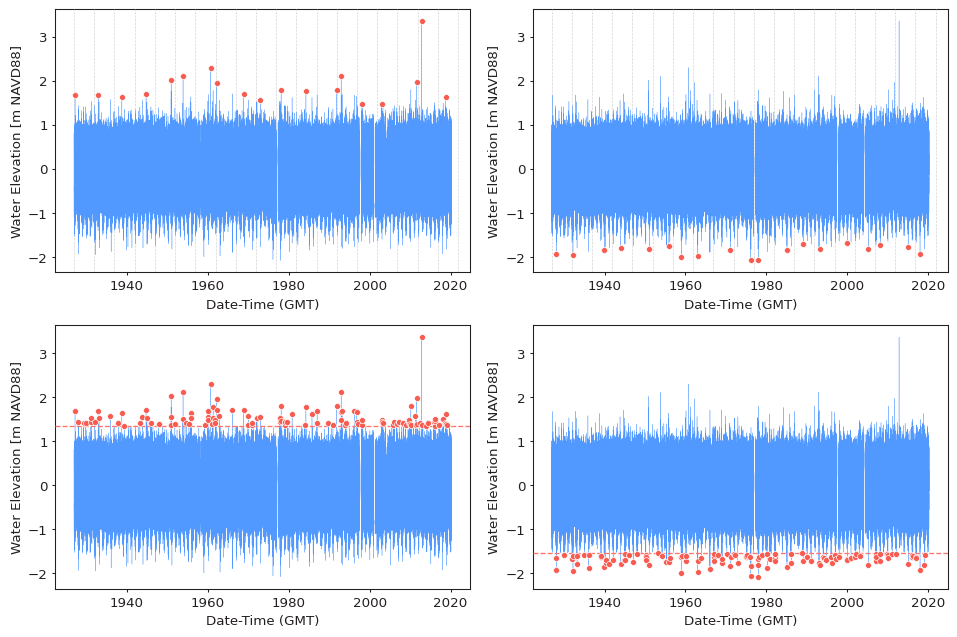Describe the bug
I read a book about extreme value statistics, and found this package. Then, I want to validate the same results are obtained or not.
The resutlts were finally not matched...
import pandas as pd
from pyextremes import EVA
KobeM = pd.Series([129.7, 51.4, 148.8, 76.3, 68.3, 91.8, 116.5, 97.4, 81.3, 65.8, 50.9, 100.2,
123.2, 199.4, 137.7, 104.7, 72.6, 63.2, 116.5, 71.9, 121.6, 87.8, 89.2, 76.2,
103.7, 112.0, 60.7, 63.2, 119.7, 75.5, 68.3, 67.6, 62.3, 51.1, 62.5, 99.4,
81.4, 86.3, 143.8, 44.5, 58.4, 270.4, 103.5, 94.0, 68.9, 80.0, 112.5, 73.4,
262.8, 58.1, 43.3, 59.0, 181.8, 117.1, 109.4, 115.9, 116.2, 175.8, 73.4, 83.7,
165.6, 56.8, 123.4, 142.2, 195.2, 130.1, 64.5, 97.1, 219.4, 95.7, 319.4, 72.5,
115.5, 53.0, 81.0, 152.0, 68.5, 83.5, 77.0, 77.5, 67.5, 91.0, 86.5, 77.0,
57.0, 125.5, 197.0, 105.5, 75.5, 128.0, 70.0, 150.0, 121.5, 72.0, 57.0, 81.0,
86.0, 40.5, 118.5, 76.5, 82.5, 122.0, 179.5, 123.0, 71.5, 38.5, 108.5, 138.0,
57.0, 76.5, 83.0, 47.0, 69.0, 105.5, 124.5, 64.0, 100.5])
KobeM.index = [pd.Timestamp(i,1,1) for i in range(1897, 2014)]
model = EVA(KobeM)
model.get_extremes(method="BM", block_size='365.2425D')
model.fit_model()
Univariate Extreme Value Analysis
========================================================================================
Source Data
----------------------------------------------------------------------------------------
Data label: None Size: 117
Start: January 1897 End: January 2013
========================================================================================
Extreme Values
----------------------------------------------------------------------------------------
Count: 116 Extraction method: BM
Type: high Block size: 365 days 05:49:12
========================================================================================
Model
----------------------------------------------------------------------------------------
Model: MLE Distribution: genextreme
Log-likelihood: -583.328 AIC: 1172.869
----------------------------------------------------------------------------------------
Free parameters: c=-0.192 Fixed parameters: All parameters are free
loc=78.353
scale=28.215
========================================================================================
R's ismev's code is this
library(ismev)
KobeM <- c(129.7, 51.4, 148.8, 76.3, 68.3, 91.8, 116.5, 97.4, 81.3, 65.8, 50.9, 100.2,
123.2, 199.4, 137.7, 104.7, 72.6, 63.2, 116.5, 71.9, 121.6, 87.8, 89.2, 76.2,
103.7, 112.0, 60.7, 63.2, 119.7, 75.5, 68.3, 67.6, 62.3, 51.1, 62.5, 99.4,
81.4, 86.3, 143.8, 44.5, 58.4, 270.4, 103.5, 94.0, 68.9, 80.0, 112.5, 73.4,
262.8, 58.1, 43.3, 59.0, 181.8, 117.1, 109.4, 115.9, 116.2, 175.8, 73.4, 83.7,
165.6, 56.8, 123.4, 142.2, 195.2, 130.1, 64.5, 97.1, 219.4, 95.7, 319.4, 72.5,
115.5, 53.0, 81.0, 152.0, 68.5, 83.5, 77.0, 77.5, 67.5, 91.0, 86.5, 77.0,
57.0, 125.5, 197.0, 105.5, 75.5, 128.0, 70.0, 150.0, 121.5, 72.0, 57.0, 81.0,
86.0, 40.5, 118.5, 76.5, 82.5, 122.0, 179.5, 123.0, 71.5, 38.5, 108.5, 138.0,
57.0, 76.5, 83.0, 47.0, 69.0, 105.5, 124.5, 64.0, 100.5)
k000 <- gev.fit(KobeM)
results are
$conv
[1] 0
$nllh
[1] 588.2654
$mle
[1] 77.8499914 28.1150960 0.1970488
$se
[1] 2.96183720 2.35426533 0.07809392
Expected behavior
I think number of iterations are not enough for this fitting.
Also, I wonder when estimating parameters, what kind of pacakges is used for parameter optimization.,,
Desktop (please complete the following information):
- OS : Linux
- Python version: 3.10.4












